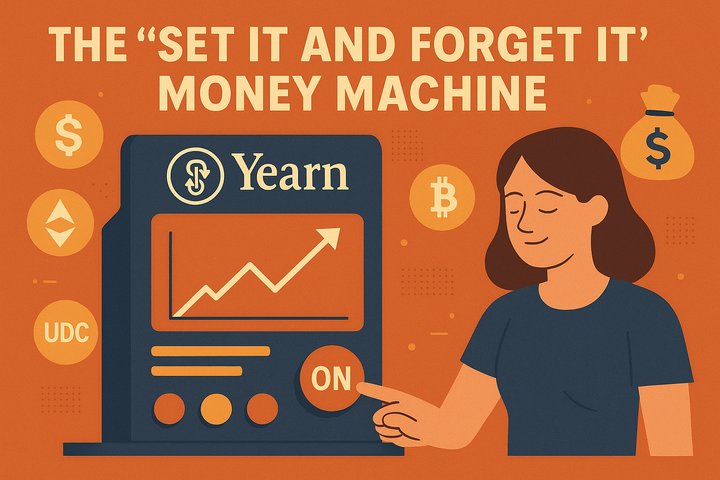CeFi Isn’t Dead It’s Just Been De Risked: Why Centralized Yield Is Back in Vogue

When the tide went out in 2022, we saw who was naked. In 2025, the ones left standing are wearing suits... and paying yield.
Remember when CeFi was the poster child of everything wrong with crypto? Collapsed lending desks, frozen withdrawals, 16 percent APY stablecoins that were really just rehypothecated hopium. Names like Celsius, Voyager, and BlockFi now live in the same graveyard as “algorithmic stablecoins” and “community multisigs.”
But three years and one regulatory purge later, CeFi is back and it's no longer pretending to be DeFi in a Halloween mask. It’s leaner. Cleaner. And, surprisingly, functioning like a real business.
Post-Collapse Purification: CeFi's Great Detox
2022 didn’t just expose bad actors, it napalmed the entire field. What emerged from the ashes wasn’t another Ponzi farm with a Discord server. It was a core group of platforms that understood credibility now costs capital.
Nexo, Coinbase, and a few others have rebuilt their reputations not on token incentives, but on real balance sheets and real yield sources, namely: staking, treasuries, and good old-fashioned interest income. Coinbase's ETH staking yield, around 3.5 to 5 percent, now looks conservative, even boring. That’s the point.
Compare that to the good old degenerate days when “yield” meant giving your ETH to a Celsius intern who YOLOed it into a Terra/Anchor loop. Not anymore.
These platforms now post proof-of-reserves, follow regulatory disclosure frameworks, and in some cases, segregate client assets. Yes, it’s still not a bank. But it’s a far cry from “Trust me, bro” tokenomics.
Real Yield, Not Imaginary Gains
What’s powering this comeback? A shift from vaporware to visible revenue.
Nexo offers up to 8 percent on stablecoins, not by lending to shadowy crypto bros in Hong Kong, but by locking funds into U.S. Treasuries or staking ETH via partners.
Coinbase routes user deposits to ETH validators, takes a fair cut, and returns the rest. Boring? Maybe. Sustainable? Yes.
And it’s working. Institutional flows, once burned and now cautious, are returning to CeFi because it offers what DeFi often can’t: simplicity, security, and sane UX. For investors who don’t want to manually farm yield across twelve chains and three bridges, CeFi is the new bond desk.
NEXO vs. COINBASE Real Yield Showdown
| Category | NEXO | COINBASE |
|---|---|---|
| Primary Yield | Up to 8–16% APY on stablecoins | ~2.23% APY on ETH staking after fees |
| Yield Source | Treasury-backed loans, staking ETH via partners | Direct ETH staking via validators |
| Custody Model | Centralized (CeFi) custody | Centralized custody (CeFi); part of publicly traded entity |
| Access Type | Earn program with loyalty tiers and lock-in options | Simple ETH staking via Coinbase UI |
| Minimum Holding | Requires >10% of portfolio in NEXO token (for max yield) | No minimums beyond staking threshold (ETH) |
| Payout Flexibility | Flexible or fixed-term interest, paid daily | Rewards accrue continuously, paid after staking activation |
| Regulation Footprint | Operates under EU and offshore frameworks (regulated in parts of Europe) | SEC scrutiny, public disclosures as a U.S.-listed firm |
Nexo vs Coinbase, pros and cons?
✅ Nexo Pros
- High APY (especially on stablecoins)
- Daily interest payout
- Flexible or fixed terms
- Broad asset support
❌ Nexo Cons
- Max APY gated behind loyalty token requirements (NEXO)
- Less regulatory clarity in some regions
- Historical scrutiny due to CeFi model
✅ Coinbase Pros
- Transparent ETH staking service
- Public company, audited financials
- Trusted brand with strong U.S. compliance
- Simple UX, no token lock-ups
❌ Coinbase Cons
- Lower yield (~2.23% APY on ETH after fees)
- High platform commission (up to 35%)
- Only ETH staking (no stablecoin yields)
| Aspect | NEXO | COINBASE |
|---|---|---|
| Yield Assets | Stablecoins (USDC, USDT, DAI), BTC, ETH | ETH only |
| User Type | Yield-maximizers willing to optimize | Hands-off investors seeking simplicity |
| Risk Profile | Higher APY, more complexity and loyalty tie-ins | Lower APY, higher brand trust |
| Transparency | Improved but still private company | Full public disclosures as a listed company |
Regulation: The New Moat
Here’s the twist nobody expected: regulation didn’t kill CeFi. It saved it.
The SEC, by gutting yield products from undercapitalized firms, left a regulatory vacuum only the best-capitalized and best-lawyered could fill. Coinbase now plays by the rules. Nexo built out compliance teams. The market finally has clear lines between securities and yield products, making stable income strategies possible without flirting with subpoenas.
This newfound compliance isn’t a burden: it’s a competitive moat. If DeFi wants to onboard TradFi capital, it still needs bridges, wallets, layer twos, oracles, and prayers. CeFi? It just needs an ACH transfer.
The Cowboys Are Gone. The Suits Are Here. And They Brought Yield.
CeFi 2.0 isn’t here to make you rich overnight. It’s here to make you not lose your stack.
You’ll still see clickbait APYs from DeFi’s Wild West. But while others are chasing 1000 percent on a cat-themed rebasing token, smart money is quietly parking capital at 5 to 7 percent in Coinbase Earn or Nexo’s treasury-backed vaults.
CeFi has become the “crypto savings account” it always claimed to be low risk, modest yield, and just boring enough to work.
Don’t Fight the Rotation
The yield game has changed. The flashy farms are drying up, and in their place we’re seeing the rise of risk-adjusted, compliant yield that doesn’t require you to read forty pages of Discord DAO drama.
CeFi is no longer pretending to be DeFi. And in doing so, it has found something DeFi still struggles with: trust.
Narratives of CeFi’s death were premature. Survivors aren’t chasing ponzis anymore, they’re stacking Treasuries and staking ETH. The cowboys are gone. The suits are here. And they brought yield.


